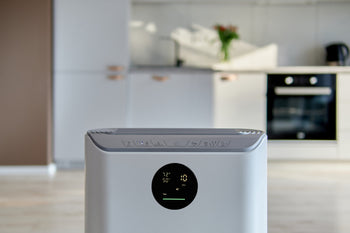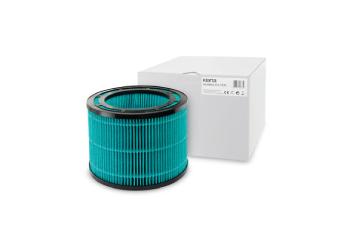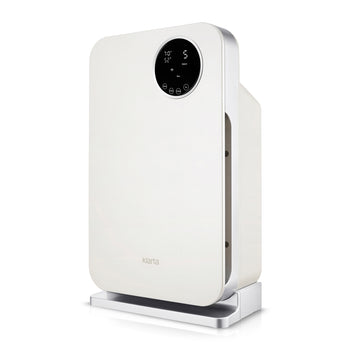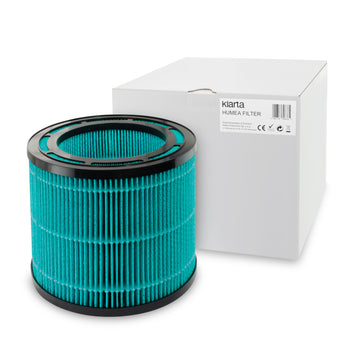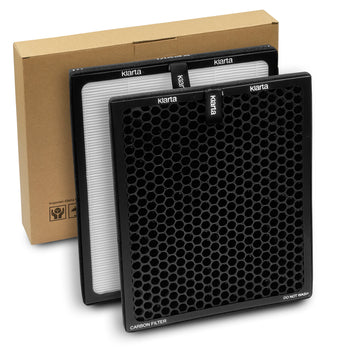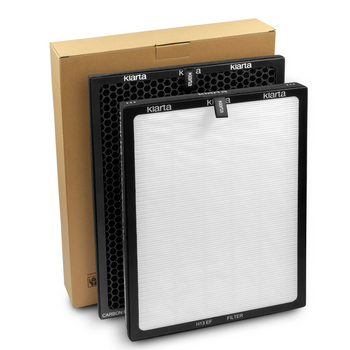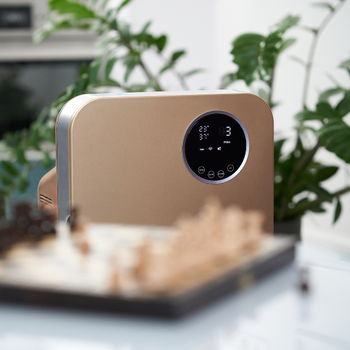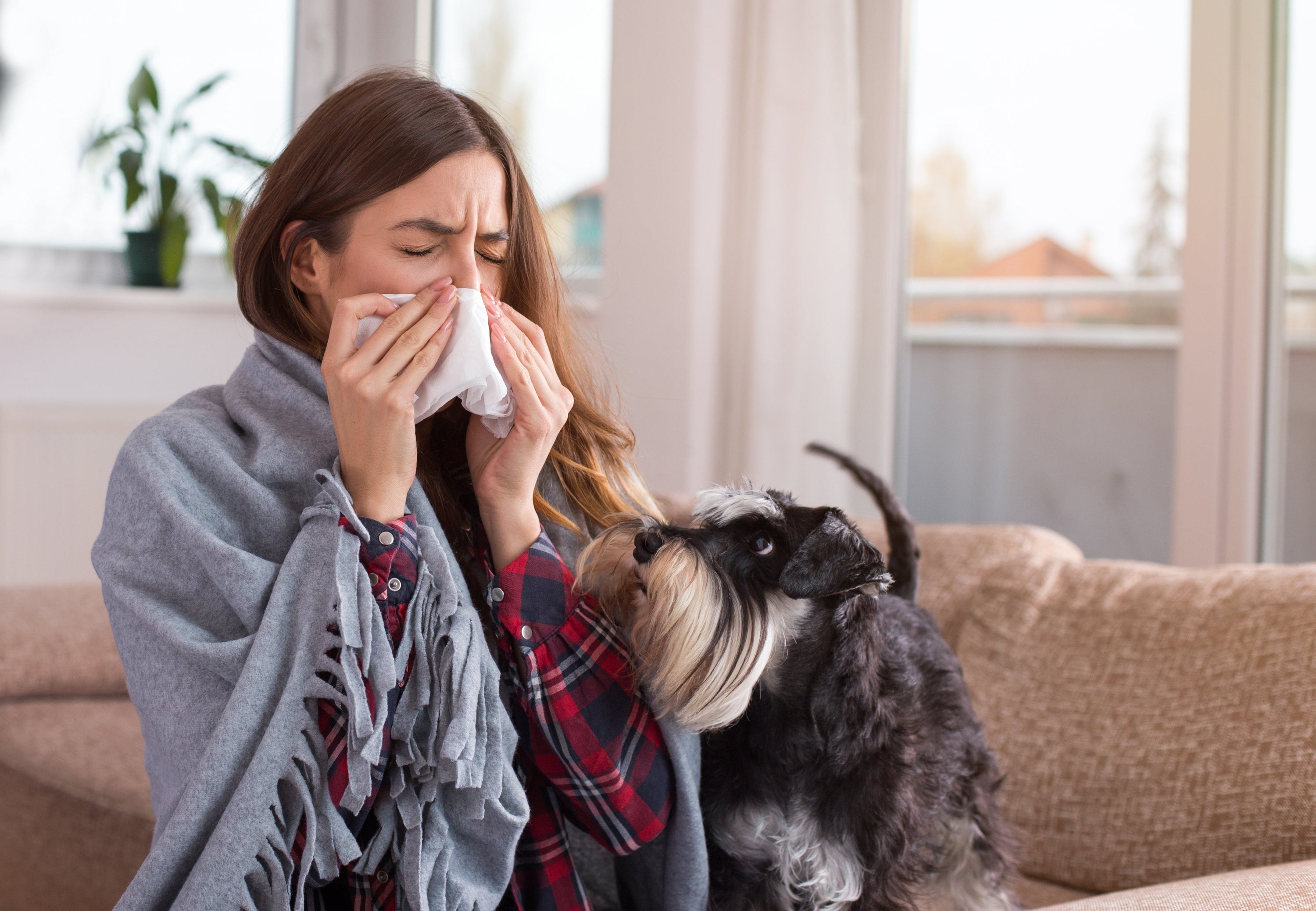
Air Purifier vs. Dog & Cat Allergies - Which Air Purifier for Relief?
An allergy to cats or dogs does not necessarily mean giving up on the dream of having a pet. Contrary to popular belief, the allergy is not to the animal’s fur but to proteins secreted by the animal’s glands. These proteins, found in micro-particle form, are most commonly found in the animal's saliva, urine, sweat, and sebaceous glands. They are also present in the dander (shed skin flakes) of the animal.
The good news is that over 75% of the Fel d 1 protein particles found in cat saliva are larger than 5 microns. Air purifiers equipped with H13 or HEPA filters can effectively reduce their amount in an allergic person's environment. And this is not the only way to alleviate allergy symptoms. What else can be done to reduce bothersome problems?

Air purifier for dogs and cats – essential elements
1. HEPA or H13 filter
Responsible for physically trapping micro-particles of pollutants: pet allergens, plant pollen, smog particles, and dust mites. The H13 filters used in Klarta air purifiers have an effectiveness of up to 99.97% for particles as small as 0.3 µm. They are also capable of capturing up to 100% of particles smaller and larger than 0.3 µm.
2. Carbon filter
Effective at removing unpleasant odors, such as those from pet litter boxes. It is the next stage of filtration responsible for neutralizing harmful gases and persistent odors. Thanks to the large amount of activated carbon used in the filters, Klarta air purifiers can quickly remove irritating odors from the room.
3. Pre-filter
Captures larger particles. This is where clumps of dust or pet hair accumulate. In Klarta air purifiers, the pre-filter is a separate, replaceable mesh that is easy to remove and reattach. The above dusty example shows how important it is to regularly clean the pre-filter. It is recommended to take out the filter, wipe it with a cloth, or gently vacuum it every 3-4 weeks.
4. Work schedule
If allergy symptoms interfere to the point of making comfortable sleep impossible, choose a device where you can program your own work schedule. Turn on the air purifier an hour before going to bed at one of the higher speeds (e.g., Fast, Fast+, or Turbo). The device will then increase its speed, stir the air, and draw allergens into the filters. For more inspiration on work rules, see the article on automating the Klarta Forste 4 air purifier.
Additionally: It is also worth investing in a humidifier. Humidified air (above 50% relative humidity) means fewer particles floating in the air. Thus, the higher the humidity, the cleaner the air and the easier it is to breathe. More humid nasal and throat mucous membranes are also an unimaginable relief for allergy sufferers.
All these elements can be found in Klarta devices. Choose an air purifier together with the Klarta Humea humidifier for areas up to 474 square ft.

Klarta Stor and Klarta Forste – 98% of allergy sufferers feel improvement
98% of allergy sufferers have confirmed the positive impact of Klarta air purifiers in alleviating allergy symptoms. 29% of them reported a complete elimination of symptoms. These results bring us joy and pride in our devices.
In cases of pet allergies, Klarta air purifiers equipped with H13 filters, IQ sensors, and uncompromising automatic modes effectively capture even microscopic particles floating in the air, trapping them on the filters inside the devices. Over 75% of the Fel d 1 protein particles in cat saliva are larger than 5 microns. Equipped with H13 filters, Klarta air purifiers can capture almost 100% of these particles.
Allergy sufferers – pay attention to these 3 things before buying an air purifier
Choose the air purifier according to the room size
- Klarta Forste – for smaller rooms up to 430 ft²
- Klarta Stor – for larger rooms up to even 860 ft²
A successful air purifier for allergy sufferers is primarily one that can mix the air in the room, causing the movement of micro-particles and directing them towards the purifier.
Before purchasing an air purifier, it is worth measuring the size of the target room (length x width x height). Effective air filtration in a room occurs when the purifier can exchange the air at least 3 times. Therefore, it is recommended to multiply the room volume by 3 to obtain the minimum cleaning capacity (CADR) that the device must have.
Choose a strict air quality evaluation algorithm
Klarta air purifiers are among the most uncompromising purifiers in Poland. The rigorous algorithm, improved over the years by our engineers, is ruthless to all dust floating in the air. Both Klarta Forste and Klarta Stor react by increasing their speed as soon as the PM2.5 level exceeds 5 µg/m³. The turbo mode is activated above 30 µg/m³.
Consider the placement of the air purifier
Many allergy sufferers place their air purifier in the bedroom, as this is where we spend at least 6-8 hours a day. Mattresses, bedding, and curtains are also good habitats for dust mites. When placing the air purifier, make sure it is reasonably close to the living areas (e.g., bed, sofa, or table) and also fairly close to the main ventilation paths in the apartment. Choosing a Klarta air purifier allows you to sleep peacefully. With the presence of night mode and 8 speed levels, our devices guarantee quiet and smooth operation without sudden speed jumps.

Allergy to cats, what is it?
A commonly perpetuated myth about cat allergies is the belief that it is an allergy to fur. However, animal fur is never the source of the allergy; it can only carry it. The allergenic factor is actually the Fel d 1 protein (secretoglobin). It is produced in the sebaceous glands and salivary glands. When an animal grooms itself, it transfers this protein to its fur.
This protein is much lighter than dog protein, making it more volatile and therefore more dangerous. It can more easily enter the respiratory tract. However, like in dogs, secretoglobin is produced in greater quantities by males. Its concentrations can also increase with the age of the animal. Research conducted in 1998 by A. Custovic and others indicates a 260-fold lower concentration of Fel d 1 allergen in rooms of people who did not own a cat compared to the rooms of cat owners. Equipped with H13 filters, Klarta air purifiers can significantly reduce the spread of the allergen in the air.
Symptoms of cat allergy
The most common symptoms of a cat allergy include:
- Runny nose
- Sneezing
- Coughing
- Scratchy throat
- Watery eyes
- Itchy eyes and swollen eyelids
- Itchy and red skin
- Eczema

Dog allergy – what is it?
Similar to cats, it is a misconception that dog fur causes allergies. The allergenic factor is actually dog dander, which can contain up to 29 allergens. However, the most commonly mentioned is the Canf5 protein (also written as Can f 5 – Canis familiaris allergen 5), which can be found in dog urine and skin. It is produced in the dog's prostate. In a Swedish study, this allergen was identified as the most allergenic.
In another study conducted on a large group of respondents, Canf5 was the most frequently recognized allergenic factor among children allergic to cats and dogs – even though only 1 in 10 children showed symptomatic allergic reactions in the presence of dogs. This confirms Dr. Lakiea Wright, an allergist at Brigham and Women’s Hospital in Boston, who believes that about 30% of people allergic to dogs are actually allergic to one specific protein.
The good news is that females are less allergenic than males. Additionally, in a study by Licciardi and others, it was found that an allergy to the Canf5 protein can be considered relatively "fortunate" because many people allergic only to this allergen can keep a female dog or a neutered male dog in their home. Older dogs, shedding more dander, are also considered more allergenic.
Symptoms of dog allergy
- Runny nose
- Sneezing
- Coughing
- Postnasal drip
- Itchy eyes and swollen eyelids
- Itchy and red skin
-
Eczema
Allergy to cats or dogs – what else is worth doing?
An air purifier is a good first step to alleviate allergy symptoms. However, it is worth making some changes to your daily life to minimize the chance of allergens "settling in."
Get rid of carpets, blankets, curtains, and drapes
These decorative elements tend to trap allergens. Carpets are particularly absorbent, making it difficult to extract embedded allergen particles, even with air purifiers. In a study by Robert A. Wood and others, removing carpets significantly increased the effectiveness of air cleaning.
Limit pets' access to the bedroom
This step may be difficult for many. We understand those who love sleeping with their pets. However, the bedroom has the most surfaces that easily absorb floating particles of cat Fel d 1 protein.
Try covers for mattresses and pillows
Made from fibers several dozen times (sometimes even 200 times) thinner than human hair, these covers act as an impermeable barrier to allergens.

Regular and conscious cleaning of the apartment
In the case of allergies, whether it's cat saliva protein or dog dander, it is worth vacuuming your rooms regularly, at least twice a week. Additionally, the floors should be washed at least once a week. When cleaning dust, remember the proper order:
1. Turn on the air purifier
2. Dust the furniture, starting from the top shelves
3. Vacuum the floors
4. Wash the floors
Check filter wear and maintain their cleanliness
Clean filters mean greater efficiency and effectiveness of air purification. A clogged pre-filter or H13 filter has limited capacity to trap additional pollutants on its surface. Consequently, the effectiveness of such a device drops from 99.97% to even half of that value. This may also result in louder operation of the purifier, as the air streams have a harder path to follow. Therefore, regularly check the condition of the pre-filter every 3-4 weeks and wipe it with a damp cloth or gently vacuum it. Replace H13 and carbon filters approximately every 12 months for Klarta Forste and every 24 months for Klarta Stor air purifiers.
Visit an allergist
Using public health services, see your primary care doctor to get a referral to an allergist. If you visit an allergist privately, no referral is needed. The allergist will likely recommend antihistamines or immunotherapy treatments.
FAQ – Frequently Asked Questions about dog or cat allergies
How to check if you are allergic to dogs?
The most common tests are ambulatory skin tests and blood tests, which check the level of allergen-specific IgE antibodies.
How to check if you are allergic to cats?
Similar to dogs, by performing skin tests and checking IgE antibodies in the blood.
Is desensitization to cats effective?
In the case of an allergy to the cat saliva protein Fel d 1, desensitization is unfortunately not as effective. The effect is usually visible but will be smaller than with desensitizing preparations for plant pollen or dust mites. The most important method of alleviating allergy symptoms is to avoid or limit contact with the cat.

